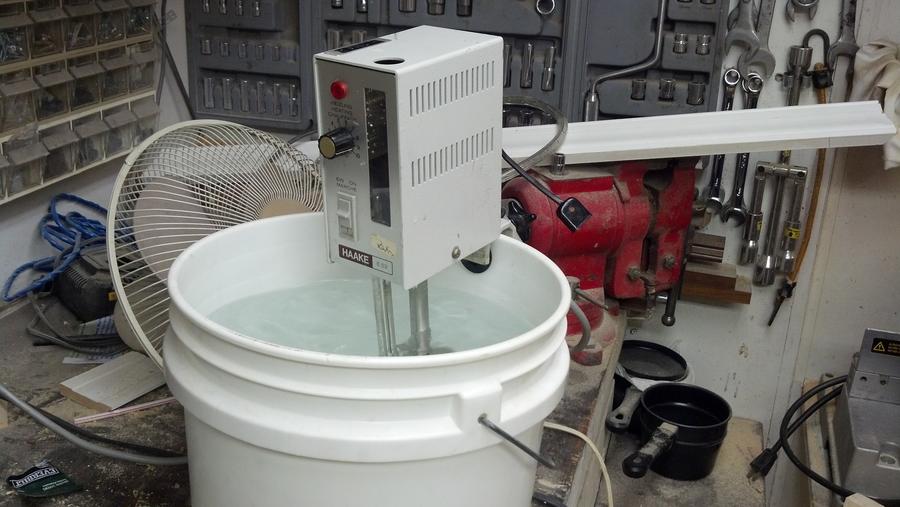This is not smoked but wanted to share.
[h3]Sous Vide Venison Roast[/h3]
[h3]Sous Vide Venison Roast[/h3]
This is my first foray into Sous Vide Cooking. I actually started reading up on this method when I was in the process of making a Corned Beef Brisket for my Brothers St. Patrick's Day Party (still in progress). I was intrigued by what I have read thus far on Sous Vide cooking and felt this is something I simply must try. I am the kind of person that if I get an idea in my head I won't be happy till I try it, if I don't try it, the idea just keeps floating around in my head and drives me crazy, there are times when I have to grab a piece of paper, letter, box anything to write on and start scribbling diagrams, notes, recipes etc... just to try and get it out of my head. While working on this project, I would wake up in the middle of the night and my mind would race with all the information I have been reading about that day, I would just lie there wide awake and put stuff together in my head... good or bad, I don't know but it does motivate me, the same is true when I built the Frankensmoker. I started building the setup for the Corned Beef I was going to cook in a few weeks, meanwhile, Mom said she had a Venison roast to give me, apparently the last venison they cooked up was inedible due to it being impossible to chew and mom figured I could use it for something, she ended up giving the unpalatable meat to my sisters dog, REALLY... Oh boy! I let her have it, I said "MOM!, next time you have unpalatable piece of meat, give it to me and I'll make stew or jerky" Anyhow, I though that this would be a a great time to test my Sous Vide machine, hell I was just as excited as I was nervous, I really wanted this to work. When I was building the controller last weekend, a few buddies stopped over and had a few beers as they watched me build the controller, yes they think I'm OFF! We got the munchies and I remembered the 18 month old pit cooked pork loin I was thawing to use in a dish, I grabbed it from the refrigerator and tossed it on the slicer and sliced it paper thin served with some dipping sauce and we were golden. Yep its great to have a refrigerator and meat slicer in the workshop. The whole time I was putting this thing together, my Wife Unit was looking at me like I was nuts. OK, enough rambling, lets do this!
Temperature controller settings
Was I lucky, was it a good piece of meat to begin with, were my taste buds numb? My son Stephen liked it, HUH! that's just crazy talk. I'm not a big venison person and eat it rarely, but this has to be, without a doubt and all bullshit aside, the best piece of venison I have ever eaten. Notes: One of my concerns with this cook was the temperature swing I was getting, since I was using a Celsius temperature controller, the swing was pretty significant as you can only set the controller with a one degree (1.8°F) minimum set limit. The temperature controller was set for 56°C and was set to kick on one degree under, using the roaster pan as a heat source the temp would climb to 57.9° Celsius due to the carry over heat from the pan. 54.9°C = 130.82°F 57.9°C = 136.22°F So a 3° variance in Celsius x 1.8 is a 5.4°F swing, granted my lower limit never got below 54.9°. I do however have another temperature controller coming in that is rated in Fahrenheit and will swap out the Celsius temperature controller, I can live with a 3° swing but not a 5.4° swing. I am also currently working on an immersion heater, hopefully this will give me better control of the water bath. After I get a few cooks under my belt and build my new Sous Vide Immersion Heater, I will be playing around with combining this with Pit cooking, Smoking, frying etc... In closing, After researching this to death and reading so many great things with this method, it was a no brainer, I just had to try it, I was hoping that all the great things I read about Sous Vide cooking were true and not folks just trying to convince themselves that cooking Sous Vide was nothing short of miraculous, especially after plopping down hundreds of dollars on a Sous Vide machine or making their own machine. Sometimes we just don't want to face the music! I have read all the science behind it and it all makes sense to me, well sort of, when explained in layman's terms, but it still blows my mind. I have to admit I was very skeptical of this method and my first test was a total success and I highly recommend giving this a shot!. |



















